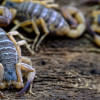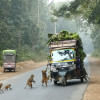Deforestation in the Brazilian Amazon reaches decade high

The destruction of Brazil's Amazon rainforest reached its highest level in a decade this year, government data released on Friday showed, driven by illegal logging and the encroachment of agriculture on the jungle.
Satellite images for the 12 months through the end of July 2018 showed that 7,900 square kilometers (3,050 square miles) of forest were cleared in the Amazon, equivalent to more than half the territory of Jamaica. That was a 13.7 percent increase from the same period in the prior year.
Deforestation is a key factor behind global warming, accounting for around 15 percent of annual emissions of heat-trapping gases, similar to that of the transportation sector.
On Friday, a US government report found that climate change will cost the United States hundreds of billions of dollars by the end of the century.
Brazil's environment minister Edson Duarte said in a statement that illegal logging was the main factor behind the increase in deforestation in the Amazon. He called on the government to increase its policing of the jungle.
The states of Pará and Mato Grosso were the largest contributors to the deforestation increase. Mato Grosso is Brazil's top grains producer, leading Brazil's booming soybean output.
Brazil's Climate Observatory, a network of non-governmental organizations, said in a separate statement that the increase was not a surprise. Besides illegal logging, it said Brazil's growing commodities sector was contributing to forest destruction as farmers sought to expand.
Marcio Astrini, from the local office of Greenpeace, said the Brazilian government had not done enough to fight deforestation and recent policy moves such as ones reducing areas under federal protection fueled environmental destruction.
Both groups said they were worried that deforestation could increase further during the government of President-elect Jair Bolsonaro, due to take office in January. He has sharply criticized the Brazilian environmental protection agency, and the agriculture sector is one of his main political bases.
Despite the recent rise, deforestation remains sharply below the levels recorded in the early 2000s, before the Brazilian government launched a strategy to fight forest destruction. In 2004, for example, more than 27,000 square km were cleared, an area the size of Haiti.
Scientists consider the Amazon as one of nature's best protections against global warming, as it acts as a giant carbon "sink" by absorbing the gas. The jungle is also rich in biodiversity, hosting billions of species yet to be studied.

 For all latest news, follow The Daily Star's Google News channel.
For all latest news, follow The Daily Star's Google News channel. 








Comments